
Sacred Texts Native American California Index Previous Next

The Indians of the Yosemite Valley and vicinity have a great fund of mythological lore, which has been handed down verbally from generation to generation for hundreds of years, but they are very reluctant to speak of these legends to white people, and it is extremely difficult to get reliable information on the subject. Moreover, the Indians most familiar with them have not a sufficient knowledge of the English language to be able to express their ideas clearly.
Many Yosemite legends have been published at different times and in various forms, and it is probable that most of them have had at least a foundation in real Indian myths, but many are obviously fanciful in some particulars, and it is impossible to tell how much is of Indian origin and how much is due to poetic embellishment. When asked about some of these legends, many years ago, one of the old Yosemite Indians
remarked contemptuously, "White man too much lie."
On the other hand, red men as well as white men are sometimes given to romancing, and I have known of cases where "legends" would be manufactured on the spur of the moment by some young Indian to satisfy an importunate and credulous questioner, to the keen but suppressed amusement of other Indians present.
It will therefore be seen that this subject is surrounded with some difficulty, and it must not be understood that the legends here given are vouched for as of wholly Indian origin. Some of them, notably those of the Tul-tok'-a-na and the second legend of Tis-sa'-ack, have been accepted by eminent ethnologists, and are believed to be purely aboriginal, while others have doubtless been somewhat idealized in translation and in the course of numerous repetitions.
The Legend of To-tau-kon-nu'-la and Tis-sa'-ack is made up of fragments of mythological lore obtained from a number of old Indians at various times during the past fifty years. It varies somewhat from other legends which have been published
regarding these same characters, but it is well known that the Indians living in Yosemite in recent years are of mixed tribal origin and do not all agree as to the traditional history of the region, nor the names of the prominent scenic features, nor even of the Valley itself. And this largely accounts for the fact that some of the legends do not harmonize with each other in details or in sentiment. All of them, however, are picturesque, and they certainly give an added interest to the natural beauties and wonders with which they are associated.
Innumerable moons and snows have passed since the Great Spirit guided a little band of his favorite children into the beautiful vale of Ah-wah'-nee, 1 and bid them stop and rest from their long and weary wanderings, which had lasted ever since they had been separated by the great waters from the happy land of their forefathers in the far distant El-o'-win (West).
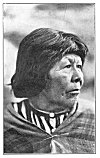
Click to enlarge
MARY.
Daughter of Captain John, one of the last Chiefs of the Yosemites.
Photograph by Boysen.
Here they found food in abundance for all. The rivers gave them plenty of la-pe'-si (trout). They found in the meadows sweet ha'-ker (clover), and sour yu-yu'-yu-mah (oxalis) for spring medicine, and sweet toon'-gy and other edible roots in abundance. The trees and bushes yielded acorns, pine nuts, fruits and berries. In the forests were herds of he'-ker (deer) and other animals, which gave meat for food and skins for clothing and beds. And here they lived and multiplied, and, as instructed by their medicine men, worshipped the Great Spirit which gave them life, and the sun which warmed and made them happy.
They also kept in memory the happy land of their forefathers. The story was told by the old people to the young, and they again told it to their children from generation to generation, and they all believed that after death their spirits would return to dwell forever in that distant country.
They prospered and built other towns outside of Ah-wah'-nee, and became a great nation. They learned wisdom by experience and by observing how the Great Spirit taught the animals and insects to live, and
they believed that their children could absorb the cunning of the wild creatures. And so the young son of their chieftain was made to sleep in the skins of the beaver and coyote, that he might grow wise in building, and keen of scent in following game. On some days he was fed with la-pe'-si that he might become a good swimmer, and on other days the eggs of the great to-tau'-kon (crane) were his food, that he might grow tall and keen of sight, and have a clear, ringing voice. He was also fed on the flesh of the he'-ker that he might be fleet of foot, and on that of the great yo-sem'-i-te (grizzly bear) to make him powerful in combat.
And the little boy grew up and became a great and wise chieftain, and he was also a rain wizard, and brought timely rains for the crops.
As was the custom in giving names to all Indians, his name was changed from time to time, as his character developed, until he was called Choo'-too-se-ka', meaning the Supreme Good. His grand o'-chum (house) was built at the base of the great
rock called To-tau-kon-nu'-la, 1 because the great to-tau'-kons made their nests and raised their young in a meadow at its summit, and their loud ringing cries resounded over the whole Valley.
As the moons and snows passed, this great rock and all the great rocky walls around the Valley grew in height, and the hills became high mountains.
After a time Choo'-too-se-ka' built himself a great palace o'-chum on the summit of the rock To-tau-kon-nu'-la, and had his great chair of state a little west of his palace, where on all festival occasions he could overlook and talk to the great multitude below; and the remains of this chair are still to be seen.
Choo'-too-se-ka' was then named To-tau-kon-nu'-la, because he had built his o'-chum on the summit of the great rock and taken the place of the to-tau'-kons. He had no wife, but all the women served him in his domestic needs, as he was their great chief, and his wishes were paramount. The many valuable donations which he received from
his people at the great annual festivals made him wealthy beyond all personal wants, and he gave freely to the needy.
One day, while standing on the top of the great dome 1 above the south wall of the Valley, watching the great herds of deer, he saw some strange people approaching, bearing heavy burdens. They were fairer of skin, and their clothing was different from that of his people, and when they drew near he asked them who they were and whence they came.
And a woman replied, "I am Tis-sa'-ack, and these are some of my people. We come from cat'-tan chu'-much (far South). I have heard of your great wisdom and goodness, and have come to see you and your people. We bring you presents of many fine baskets, and beads of many colors, as tokens of our friendship. When we have rested and seen your people and beautiful valley we will return to our home."
To-tau-kon-nu'-la was much pleased with his fair visitor, and built a large o'-chum for her and her companions on the summit
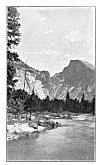
Click to enlarge
HALF DOME (TIS-SA'-ACK),
5,000 Feet.
Named for a woman In Indian mythology who was turned to stone for quarreling with her husband. See ''Legend of Tis-sa'-ack.''
Photograph by Foley.
of the great dome at the east end of the Valley, 1 and this dome still retains her name,
And she tarried there and taught the women of Ah-wah-nee how to make the beautiful baskets which they still make at the present day; and To-tau-kon-nu'-la visited her daily, and became charmed with her loveliness, and wanted her to remain and be his wife, but she denied him, saying, "I must return to my people," and, when he still persisted, she left her o'-chum in the night, and was never seen again. And the love-stricken chieftain forgot his people, and went in search of her, and they waited many moons for his return and mourned his long absence, but they never saw him more.
This was' the beginning of a series of calamities which nearly destroyed the great tribe of Ah-wah-nee'-chees. First a great drouth prevailed, and the crops failed, and the streams of water dried up. The deer went wild and wandered away. Then a dark cloud of smoke arose in the East and obscured the sun, so that it gave no heat,
and many of the people perished from cold and hunger. Then the earth shook terribly and groaned with great pain, and enormous rocks fell from the walls around Ah-wah'-nee. The great dome called Tis-sa'-ack was burst asunder, and half of it fell into the Valley. A fire burst out of the earth in the East, and the ca'-lah (snow) on the sky mountains was changed to water, which flowed down and formed the Lake Ah-wei'-yah. 1 And all the streams were filled to overflowing, and still the waters rose, and there was a great flood, so that a large part of the Valley became a lake, and many persons were drowned.
After a time the Great Spirit took pity on his children, and the dark cloud of smoke disappeared, the sun warmed the Valley again into new life, and the few people who were left had plenty of food once more.
Many moons afterwards there appeared on the face of the great rock To-tau-kon-nu'-la the figure of a man in a flowing robe, and with one hand extended toward the West, in which direction he appears to be
traveling. This figure was interpreted to be the picture of the great lost Chieftain, indicating that he had gone to the "happy hunting grounds" of his ancestors, and it is looked upon with great veneration and awe by the few Indians still living in Yosemite.
At about the same time the face of the beautiful Tis-sa'-ack appeared on the great flat side of the dome which bears her name, and the Indians recognized her by the way in which her dark hair was cut straight across her forehead and fell down at the sides, which was then considered among the Yosemites as the acme of feminine beauty, and is so regarded to this day.
Tis-sa'-ack and her husband traveled from a far-off country, and entered the Valley footsore and weary, She walked ahead, carrying a great conical burden-basket, which was supported by a band across her forehead, and was filled with many things. He followed after, carrying a rude staff in his hand and a roll of woven skin blankets over his shoulder. They had come across the mountains and were very thirsty, and

Click to enlarge
A BURDEN BEARER.
The women are the principal burden bearers, and all the others are carried in large baskets, supported by a band across the forehead.
Photograph by Fiske.
they hurried to reach the Valley, where they knew there was water. The woman was still far in advance when she reached the Lake Ah-wei'-yah, 1 and she dipped up the water in her basket and drank long and deep. She was so thirsty that she even drank up all the water in the lake and drained it dry before her husband arrived. And because the lake was dry there came a terrible drouth in the Valley, and the soil was dried up and nothing grew.
And the husband was much displeased because the woman had drunk up all the water and left none for him, and he became so angry that he forgot the customs of his people and beat the woman with his staff. She ran away from him, but he followed her and beat her yet more. And she wept, and in her anger she turned and reviled her husband, and threw her basket at him. And while they were in this attitude, one facing the other, they were turned into stone for their wickedness, and there they still remain. The upturned basket lies beside the husband, where the woman threw it, and the woman's
face is tear stained with long dark lines trailing down.
Half-Do-me is the woman Tis-sa'-ack and North Dome is her husband, while beside the latter is a smaller dome which is still called Basket Dome to this day.
The significance and derivation of the name "Yosemite," as given by old Tenei'ya, chief of the tribe, have been explained in another chapter, but there is also a legendary account of its origin, which may be of interest.
Long, long ago, when the remote ancestors of the Yosemite Indians dwelt peacefully in the valley called Ah-wah'-nee, 1 one of the stalwart young braves of the tribe went early one morning to spear some fish in the lake Ah-wei'-yah. 2 Before reaching his destination he was confronted by a huge grizzly bear, who appeared from behind one of the enormous boulders in that vicinity. and savagely disputed his passage.
Being attacked in this unexpected manner, the Indian defended himself to the best
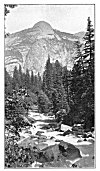
Click to enlarge
NORTH DOME (TO-KO'-YA),
3,725 Feet.
This rock is believed by the Indians to represent Tis-sa'-ack's husband. turned into stone for beating his wife. The lower dome to the right is the basket which she threw at him. See ''Legend of Tis-sa'-ack.''
Photograph by Fiske.
of his ability, using for the purpose the dead limb of a tree which was near at hand, and, after a long and furious struggle, in which he was badly wounded, he at length succeeded in killing the bear.
His exploit was considered so remarkable by the rest of the tribe that they called him Yo-sem'-i-te (meaning a full-grown grizzly bear), in honor of his achievement, and this name was transmitted to his children, and eventually to the whole tribe.
There were once two little boys living in the Valley of Ah-wah-nee, who went down to the river to swim. When they had finished their bath they went on share and lay down on a large boulder to dry themselves in the sun. While lying there they fell asleep, and slept so soundly that they never woke up again. Through many moons and many snows they slept, and while they slept the great rock 1 on which they lay was slowly rising, little by little, until it soon lifted them up out of sight, and their friends searched for them everywhere without success.
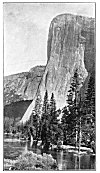
Click to enlarge
EL CAPITAN (TO-TAU-KON-NU'-LA),
3,300 Feet.
The Indians believe that this great rock grew from a small boulder. See ''Legend of the Tul-tok'-a-na.''
Photograph by Foley.
[paragraph continues] Thus they were carried up into the blue sky, until they scraped their faces against the moon; and still they slept on.
Then all the animals assembled to bring down the little boys from the top of the great. rock. Each animal sprang up the face of the rock as far as he could. The mouse could only spring a hand's breadth, the rat two hands' breadths, the raccoon a little more, and so on. The grizzly bear made a great leap up the wall, but fell back like all the others, without reaching the top. Finally came the lion, who jumped up farther than any of the others, but even he fell back and could not reach the top.
Then came the tul-tok'-a-na, the insignificant measuring worm, who was despised by all the other creatures, and began to creep up the face of the rock. Step by step, little by little, he measured his way up until he was soon above the lion's jump, and still farther and farther, until presently he was out of sight; and still he crawled up and up, day and night, through many moons, and at length he reached the top, and took the little boys and brought them safely down to the ground. And therefore the rock was named
for the measuring worm, and was called Tu-tok-a-nu'-la.
I will here relate a personal experience which occurred in September, 1857, while out with a large party of Indians on a deer hunt in the mountains.
One day, after a long tramp, I stopped to rest by the side of a small lake about eight miles from the present site of Wawona, and I then named it Grouse Lake on account of the great number of grouse found there. Very soon a party of Indians came along carrying some deer, and stopped on the opposite side of the lake to rest and get some water. Soon after they had started again for their camp I heard a distinct wailing cry, somewhat like the cry of a puppy when lost, and I thought the Indians must have left one of their young dogs behind.
When I joined the Indians in camp that night I inquired of them about the sound I had heard. They replied that it was not a dog--that a long time ago an Indian boy had been drowned in the lake, and that every time any one passed there he always cried after them, and that no one dared to
go in the lake, for he would catch them by the legs and pull them down and they would be drowned. I then concluded that it must have been some unseen water-fowl that made the cry, and at that time I thought that the Indians were trying to impose on my credulity, but I am now convinced that they fully believed the story they told me.
Po-ho'-no Lake, the headwaters of the Bridal Veil Creek, was also thought to be haunted by troubled spirits, which affected the stream clear down into the Yosemite Valley; and the Indians believed that an evil wind there had been the cause of some fatal accidents many years ago. The word Po-ho'-no means a puffing wind, and has also been translated "Evil Wind," on account of the superstition above referred to.
Tee-hee'-nay was a beautiful Ah-wah-nee maiden, said to be the most beautiful of her tribe, and she was beloved by Kos-su'-kah, a strong and valiant young brave. Valuable presents had been made to the bride's parents, and they had given their consent to an early marriage, which was to be celebrated by a great feast.
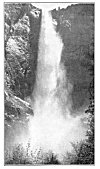
Click to enlarge
BRIDAL VEIL FALL (PO-HO'-NO),
940 Feet.
The source of this stream is supposed by the Indians to be haunted by troubled spirits, which affect the water along its whole course. The word Po-ho'-no means a ''puffing wind.''
Photograph by Fiske.
To provide an abundance of venison and other meat for this banquet, Kos-su'-kah gathered together his young companions and went into the mountains in search of game. In order that Tee-hee'-nay might know of his welfare and the success of the hunt, it was agreed between the lovers that at sunset Kos-su'-kah should go to the high rock to the east of Cho'-lack, 1 and should shoot an arrow into the Valley, to which should be attached a number of grouse feathers corresponding to the number of deer that had fallen before the skill of the hunters.
At the time appointed Tee-hee'-nay went near the foot of the great cliff and waited, with her eyes raised to the towering rocks above, hoping with her keen sight to see the form of her lover outlined against the sky, but no form could she see, and no arrow fell into the Valley. As darkness gathered, gloomy forebodings took possession of her, and she climbed part way up the canyon called Le-ham'-i-tee 2 because the arrow-wood grew there, and finally she stood at the
very foot of the rocky wall which rose to dizzy heights above her, and there she waited through the long night.
With the first streak of dawn she bounded swiftly up the rough canyon, for she was fully convinced that some terrible fate had overtaken the brave Kos-su'-kah, and soon she -stood upon the lofty summit, 1 where she found her lover's footsteps leading towards the edge of the precipice. Drawing nearer she was startled to find that a portion of the cliff had given way, and, upon peering over the brink, what was her horror to discover the blood-stained and lifeless body of Kos-su'-kah lying on a rocky ledge far beneath.
Summoning assistance by means of a signal fire, which was seen from the Valley below, a rope was made of sapling tamaracks lashed firmly together with thongs from one of the deer that was to have furnished the marriage feast, and Tee-hee'-nay herself insisted on being lowered over the precipice to recover the body of her lover. This was at last successfully accomplished, and when his ghastly form lay once
more upon the rocky summit, she threw herself on his bosom and gave way to a passionate outburst of grief.
Finally she became quiet, but when they stooped to raise her they found that her spirit had fled to join the lost Kos-su'-kah, and that the lovers were re-united in death.
The fateful arrow that was the cause of so much sorrow could never be found, and the Indians believe that it was taken away by the spirits of Kos-su'-kah and Tee-hee'-nay. In memory of them, and of this tragedy, the slender spire of rock 1 that rises heavenward near the top of the cliff at this point is known among the Indians as Hum-mo', or the Lost Arrow.
78:1 Yosemite Valley.
82:1 El Capitan.
83:1 Sentinel Dome.
85:1 Half Dome.
86:1 Mirror Lake.
89:1 Mirror Lake.
90:1 Yosemite Valley.
90:2 Mirror Lake.
92:1 El Capitan.
98:1 Yosemite Falls.
98:2 Now known as Indian Canyon.
99:1 Yosemite Point.
100:1 Sometimes called "The Devil's Thumb."